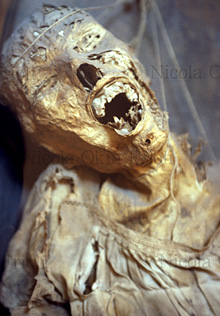
|  |  |  Vallarta Living | Art Talk | October 2008 Vallarta Living | Art Talk | October 2008  
Mommy, There's a Mummy!
 Pablo Jaime Sáinz - San Diego Union-Tribune Pablo Jaime Sáinz - San Diego Union-Tribune
go to original


| “The Mummies of Guanajuato”
When: Through Nov. 12, 9 a.m. to 8 p.m.
Where: El Foro, Old Jai Alai Palace, Avenida Revolución, Tijuana
Tickets: $4.50 adults, $.50 students and seniors
Getting there: Mexicoach offers a nonstop, two-way transportation service between the border and the exhibition
Phone: 011-52-664-688-1721 | | |
Kids and adults will be delighted by slice of Mexican culture on exhibit in Tijuana

Guanajuato is one of the most mysterious cities in Mexico. Its legends of ghosts who wander through its colonial alleys are well known, among them La Llorona, that grieving soul legend says is always searching for her children.

Among the most deeply ingrained traditions in Mexican popular culture are the mummies of Guanajuato, which saw their popularity wax in the 1970s when El Santo, the Man with the Silver Mask, made several mummy movies.

Eighteen mummies have arrived in Tijuana straight from the Guanajuato Mummy Museum just in time for the Day of the Dead celebrations. The remains are part of a traveling exhibition that will visit many Mexican cities and will be in Tijuana through Nov. 12.

“People are very curious to see the mummies up close,” says Lizeth García, outreach coordinator for the Tijuana Municipal Institute of Arts and Culture, which is presenting the exhibition. “Maybe it's morbid fascination, maybe it's because these mummies are an important part of our popular culture, but the truth is they're attracting a lot of people.”

Going back some 150 years, Guanajuato's mummies have become an important part of Mexican culture. The first mummy was found in 1870 and is the body of a French physician discovered in that city's Santa Paula cemetery.

The mummification of the bodies was a natural phenomenon, the product of a combination of the clay and limestone crypts, humidity levels and temperatures found on the mineral-rich soil of the cemetery, says Gabriel Rivera, coordinator of Tijuana's Historical Archive.

“The fascination these mummies hold is impressive,” he says.

Rosy Benítez, who recently visited the exhibit with her 7-year-old daughter Génesis, says she felt some fear before seeing the mummies, but that vanished when she saw them.

“I realized that death is just a natural process, a change in our bodies'development,” says Benítez.

The exhibition starts off with a three-minute video on the Day of the Dead tradition in Mexico. The 18 mummies are divided into three sections, each a showcase of the history of natural mummification in Guanajuato. One section features the bodies of three children who were buried in the traditional gown of their families' patron saints. Museum guides in each section offer a wealth of details.

The Guanajuato Mummy Museum holds almost 200 mummies. The 18 in the traveling exhibit represent a good opportunity to get to know this cultural phenomenon without having to visit central Mexico. |

 |
|  |



